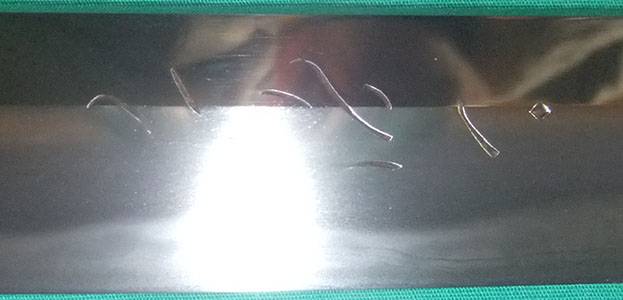Blade length 52.4cm, thickness at the base 7mm, width 3.1cm
This is a nice blade made by Fusamune who is a good smith in Sagami province in the beginning of 16th century. He is a real "smith of Soshu" (Soshu = Sagami province), but not a legendary ghost smith.
He did not work in Kamakura, but in Odawara. In 16th century, Odawara was a city surrounding a big castle of Hojo clan, while Kamakura became a remote village of fishermen. Many smiths in Kamakura moved to Odawara back then.
This blade is not very long, the thickness of the back is thin, and the tang is short. It shows a typical style of so-called "katate-uchi" blade what means single-hand-swing sword. It is the style we often found in 15th - 16th century.
Steel is fine, with wood grain layer pattern.

Hamon on the obverse side is not very neat around the middle part. The temper line becomes blurred. But the start part and the upper part near the kissaki has a bright hamon. Probably such a blurred temper line is because of wearing by many times polishing.
On the other side, the entire hamon is perfect. It is an active pattern made of bright particles, kinsuji runs in it, and jumping hamon (tobi-yaki) appears. So this hamon pattern is a kind of Hitatsura. It is very attractive for eye. But the real beauty of this hamon is the brightness of hamon particles.
Utsuri also appears clearly.
Those characters show the typical style of Fusamune, and also the Soshu style in that age as well.
Polishing is good enough.
Hamon sketch
Engraving
On obverse side "Hachiman-daibosatsu" (a god of war)
On the reverse side, Sanskrit letter of "Fudo-myo-Oh" or "Aizen-myo-Oh" (a buddha of love).
Tang
Signature "Fusamune"
"Soshu swords" (blades made by smiths of Sagami province) have big popularity among collectors. But, genuine ones are rare, while we can find a lot of swords without signature and attributed to famous smiths of Soshu. This situation is very strange comparing with swords of Osafune or other schools. Some famous Soshu smiths are really ghosts, since we can't find any genuine one. They say it was a strategy of Hon'nami family to create more masterpieces with appreciating Soshu swords too much. We don't know the truth.
Anyway, in such a situation of Soshu swords, this is an important sample to study what real Soshu sword is. The smith "Fusamune" is famous, but still rare. Our smith kokaji says that he has only studied a few genuine Fusamune blades in his hand during 50 years of his sword studying. And this is one of them. We recommend this sword for serious sword lovers who like Soshu sword.
Habaki shows the cross section of the blade.